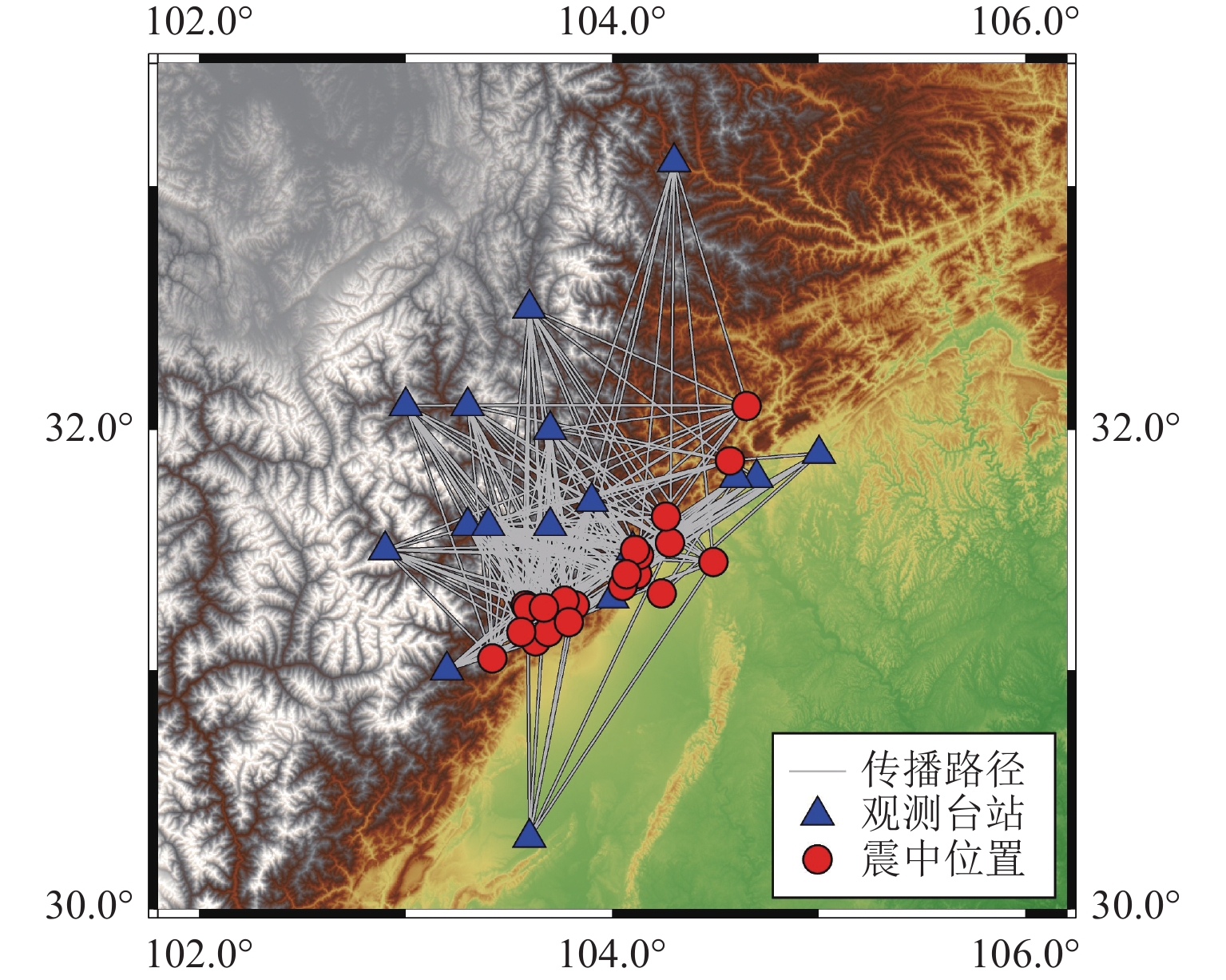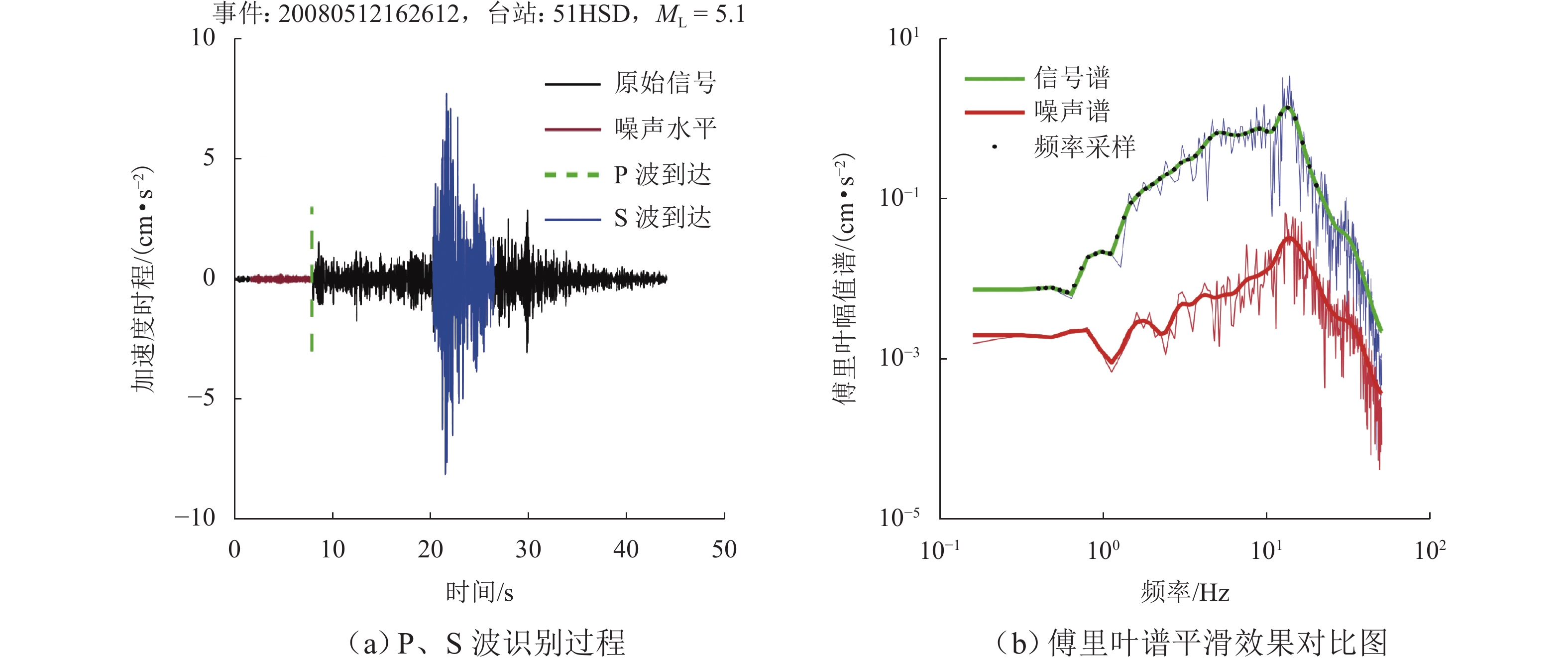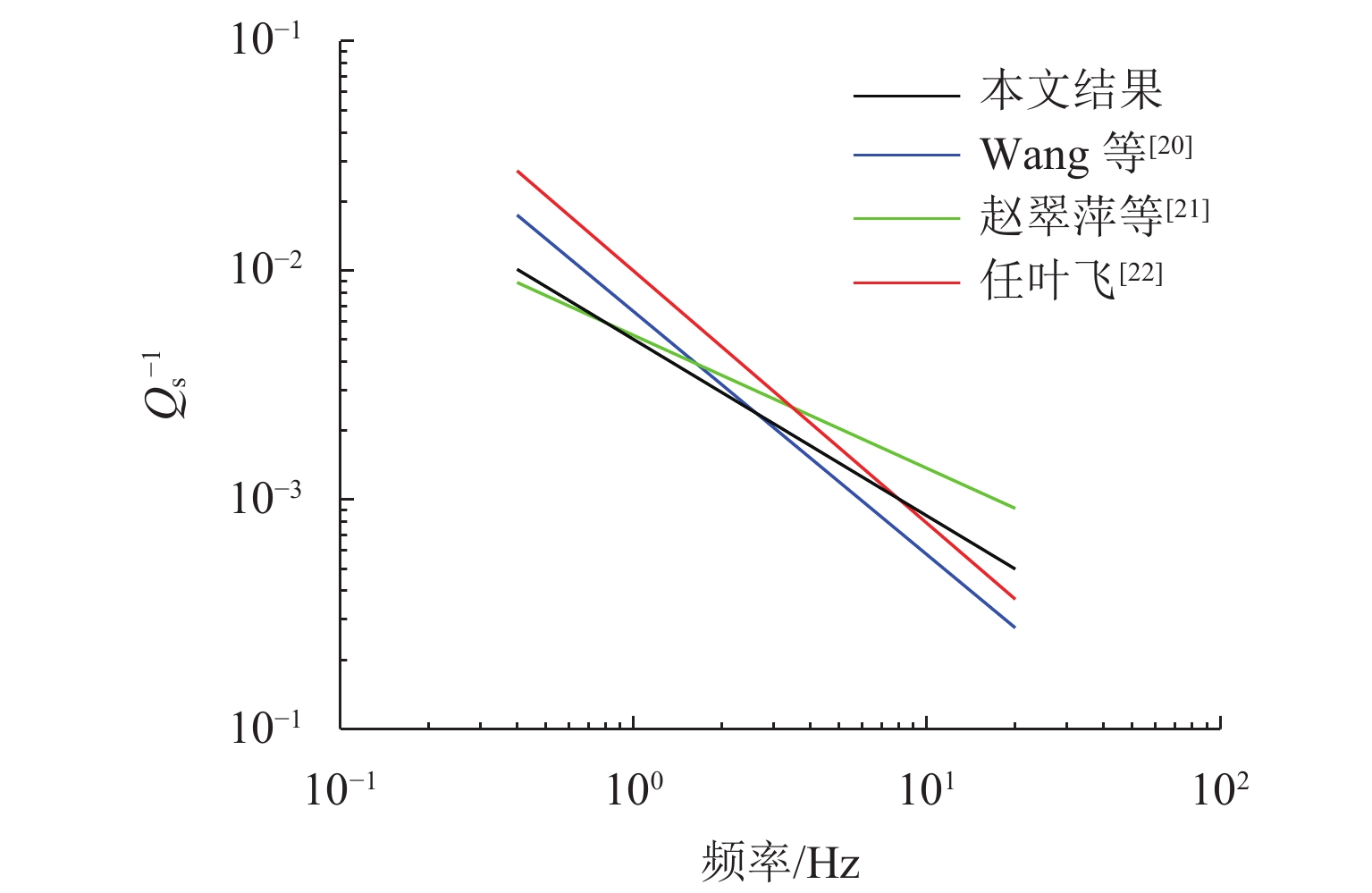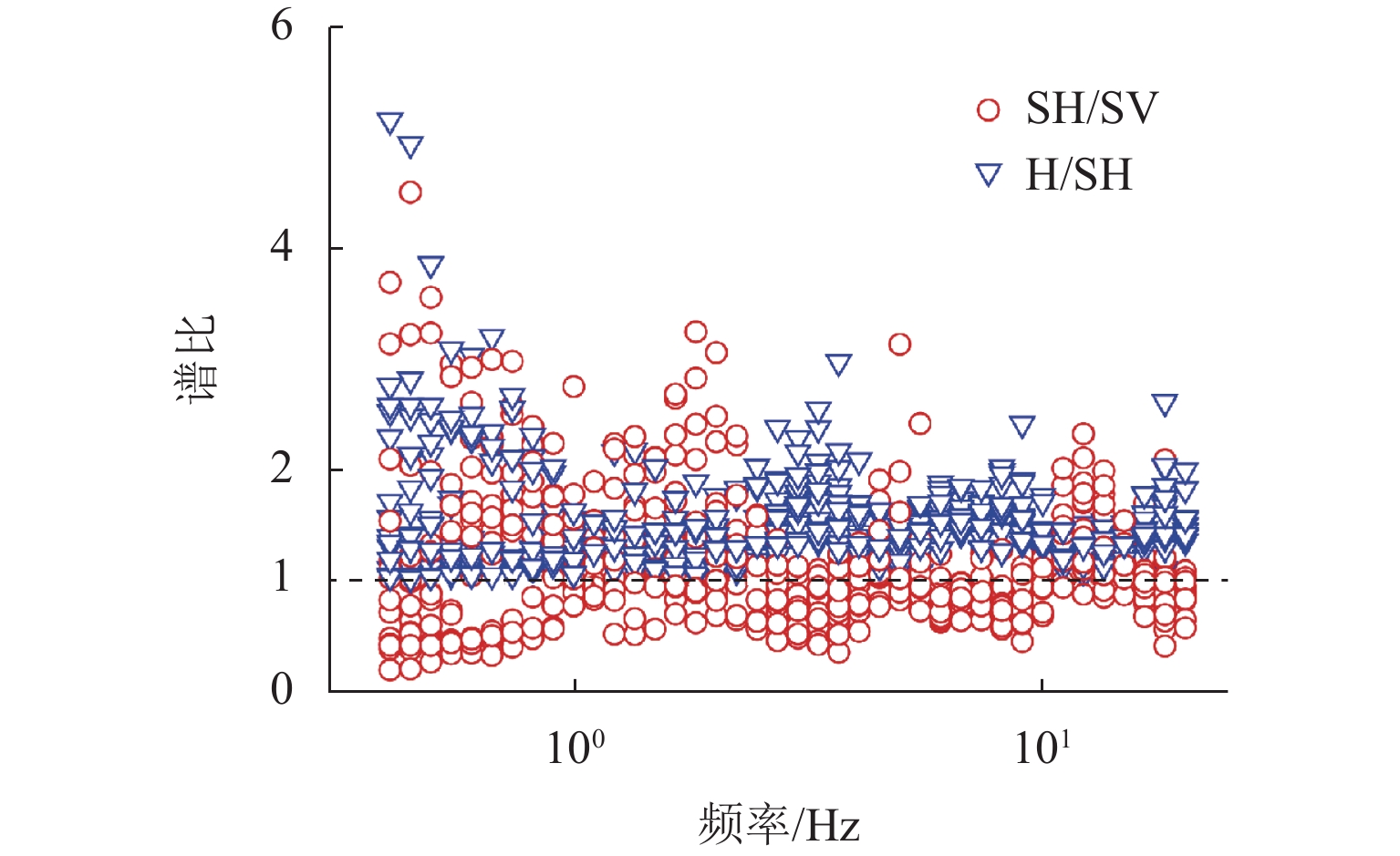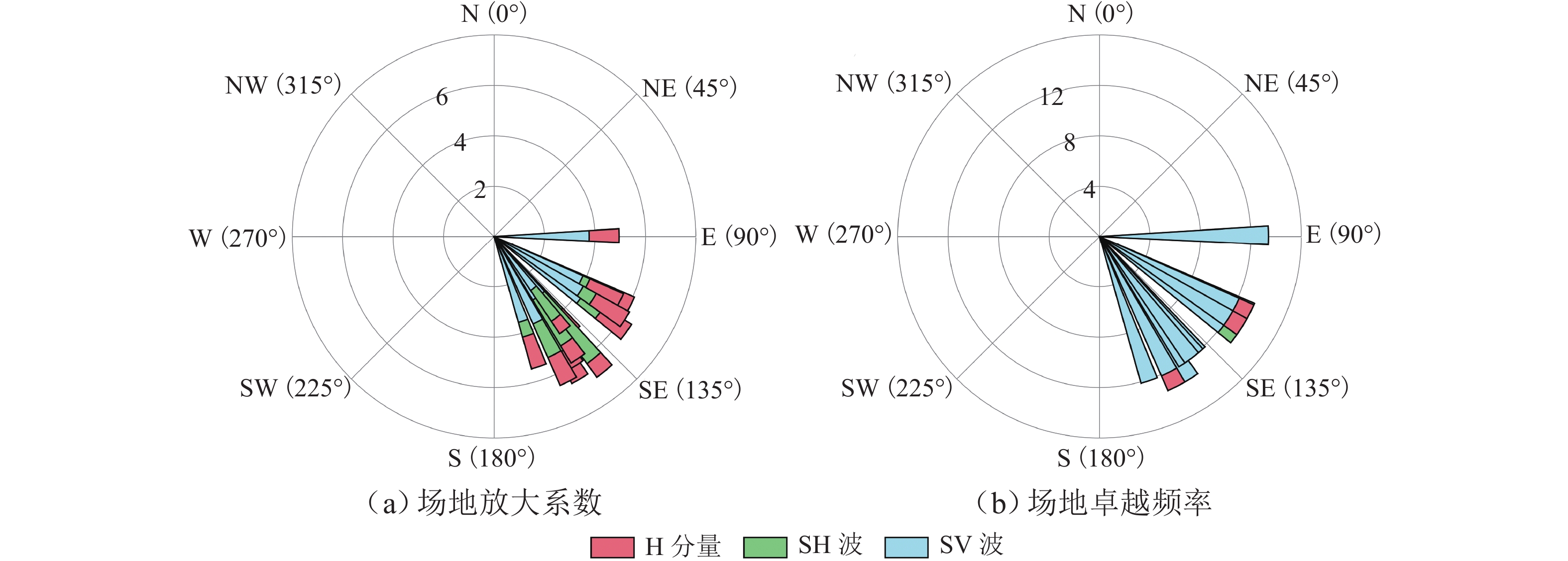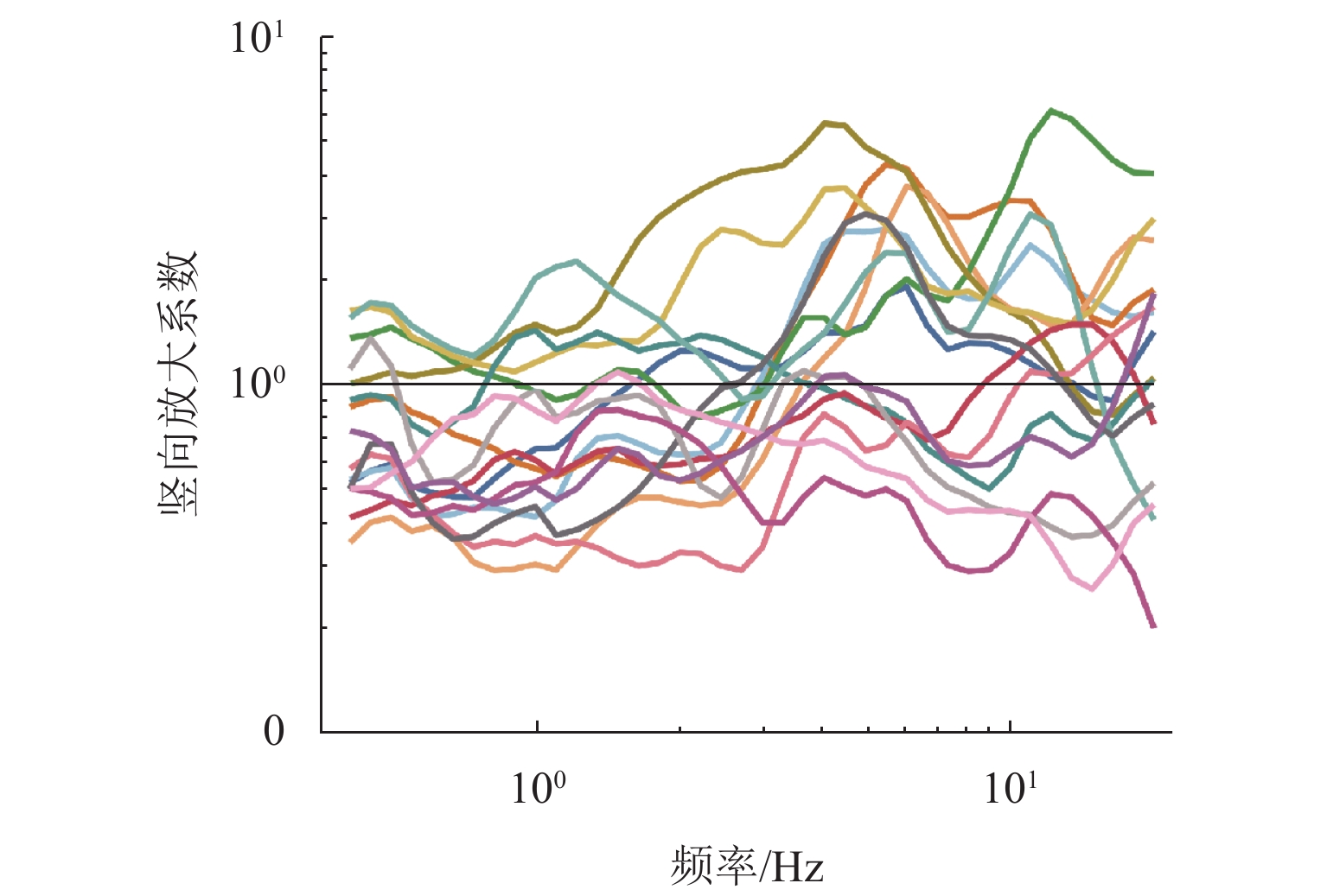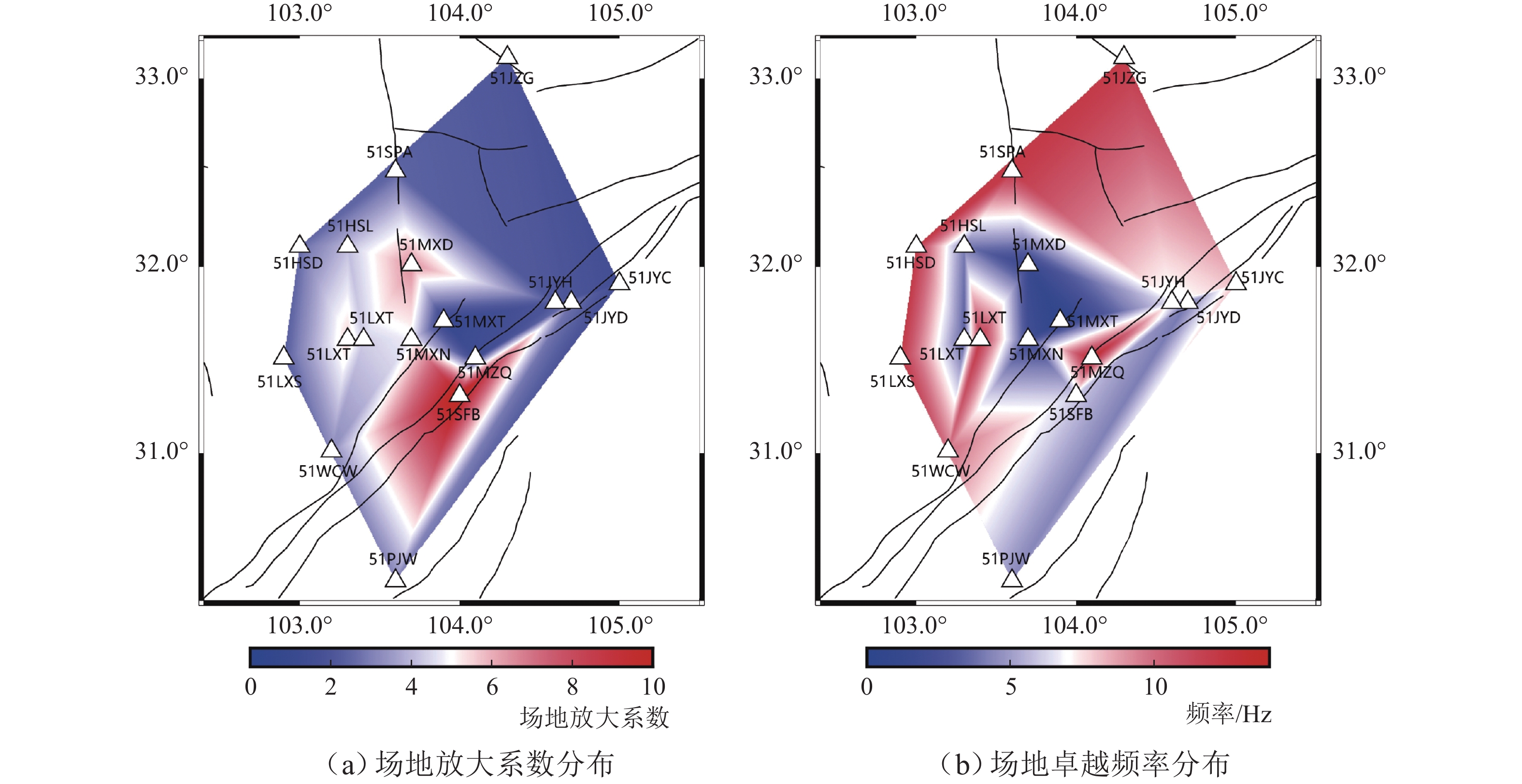Site Effects of Linear Method and Modified Horizontal-to-Vertical Spectral Ratio
-
摘要:
为进一步研究工程地震动场地效应的影响,基于水平垂直谱比法(HVSR)、线性反演法2种经验方法对四川强震区地震动场地效应进行对比分析. 首先,依据震级、台站、震中距离等因素挑选出汶川地震余震中由17个强震动台站捕获的233组强震动波形;其次,基于龙门山地区铰链三段式衰减模型,采用线性反演法估计S波的品质因子
Q s,同时应用旋转HVSR、多向HVSR 2种方法解释了地震波传播中方位角对HVSR场地效应的影响机制;最后,分析了线性反演法与HVSR法计算的场地效应产生差异性的原因,在此基础上提出了改进的HVSR法以提高场地效应评估的准确性. 研究结果发现:该区域S波的品质因子与频率相关,且在0.4~20.0 Hz内近似等于199.2f 0.8 (f 为频率);HVSR的结果具有优势方向,随着方位角的改变,场地效应会在某一角度突然增大,与场地土层的各向异性有关;竖向地震动的放大,即场地土层、工程基岩或中深部硬岩层耦合形成的竖向场地效应,是HVSR法与线性反演法产生差异的主要原因.Abstract:In order to further study the influence of site effects from engineering ground motion, a comparative analysis of site effects from ground motion in the Sichuan strong earthquake area was carried out based on two empirical methods, namely, horizontal-to-vertical spectral ratio (HVSR) and linear inversion. Firstly, 233 sets of strong motion waveforms captured by 17 strong motion stations during the aftershocks of the Wenchuan Earthquake were selected based on the magnitude, station, distance from the epicenter, and other factors. Second, the linear inversion method was used to estimate the quality factor
Q s of the S-wave based on the hinged three-stage attenuation model in the Longmenshan area. Meanwhile, two methods, rotational HVSR and multidirectional HVSR, were applied to explain the mechanism of the site effect of azimuthal angle on HVSR in seismic wave propagation. Finally, the possible reasons for the variability of the site effects calculated by the linear inversion and HVSR methods were analyzed, based on which an improved HVSR method was proposed to improve the accuracy of the site effect assessment. The results show that the quality factor of the S-wave in the area is frequency-dependent and approximately equals to 199.2f 0.8 in the range of 0.4–20.0 Hz. The results of HVSR may have a certain dominant direction, and the site effect may increase suddenly at a certain angle with the change of the azimuthal angle, which may be related to the anisotropy of the soil layer at the site. The amplification of vertical ground motion, i.e., the vertical site effect formed by the coupling of soil layer at the site, engineered bedrock, or middle and deep hard rock layers, is the main reason for the difference between HVSR and linear inversion methods.-
Key words:
- site effects /
- Qs value /
- linear inversion /
- HVSR method /
- azimuthal angle
-
场地效应被广泛定义为特定的近地表地质特征对地震波的影响,可以显著改变地震运动的峰值、持续时间和频谱幅度[1]. 受软土沉积物的各向异性或不均匀性、局部地形、沉积盆地深度和近地表衰减等多维效应的影响,量化场地效应具有挑战性.
地震危险性评估旨在预测特定区域或场地的地面运动强度,其核心手段是采用经验记录数据后进行回归分析以构建地震动预测方程(GMPEs). 在GMPEs中,场地效应通常由场地卓越频率和地下30 m的平均剪切波速(Vs30)表征. Vs30参数可以反映一些场地特性,但不足以描述考虑场地下方土壤特性引起地面运动频率相关的场地放大[2]. 随着概率地震危险性分析的不断深入,对场地效应进行更为精细的定量评估以改进地震危险性分析正逐渐成为研究焦点[3-4].
近年来,基于地表观测记录与土层底部输入运动之比为场地放大的认识,提出了用不同的经验方法来获取频率相关的场地放大系数,如井上井下谱比法、传统谱比法[5]、水平垂直谱比法(HVSR)[6]等. 由于钻孔技术在世界各地并未完全得到发展,井上井下谱比法的使用存在一定限制性. 传统谱比法假设地表基岩场地的记录相当于土层底部输入值,但在土层场地紧靠地表基岩场地时才有效[5],地震动广义反演技术(GIT)的提出克服了这一局限性[7]. 广义反演技术又称为线性反演法,通过对强震记录的联合反演,可以高效地分离强震记录中震源、路径、场地的3种贡献[8-9]. HVSR假设地下基岩的各向是同性的[6],使用单台记录H/V即可得到场地效应[10]. GIT需要大量的强震数据作为支持,而HVSR的适用性至今备受争议[11].
该研究选取由 17 个强震动台站获取的21个汶川地震余震中的 233 组强震动记录,采用广义线性反演法、HVSR法对比研究该区域内的局部场地效应,讨论了地震波传播的方向性对HVSR的影响,同时使用线性反演法对HVSR进行经验修正. 本文结果可对该区域的地震危险性分析提供重要的参考.
1. 强震数据
1.1 数据选取
基于汶川余震强震动波形记录展开研究,HVSR方法只需要单个台站强震波形即可获取场地效应值. 因此,采用线性反演法的数据选取原则:
1) 选取地表岩石台站作为参考台站,同时不考虑未被参考台站记录到的地震事件.
2) 选取10 km≤震源距≤150 km,考虑对区域内的衰减路径的影响[12].
3) 选择2 cm/s2≤PGA<150 cm/s2的记录,PGA为地面运动的峰值加速度. 考虑到一组强震记录包括3个不同方向的PGA值,采取各组中PGA的最大值作为评估标准,目的是一定程度地消除背景噪声与场地土层非线性效应的影响.
4) 保证选取的每个台站记录到5次以上的事件,且每个事件被5个及以上台站记录到.
基于以上原则,该研究共选取了17个台站在21次地震中记录到的233组三分量强震记录,台站51MXT是线性反演的参考站,该台站布设于稳定的露头岩石[13]. 强震动波形记录的PGA与震源距的关系如图1所示. 可以发现:大部分记录都小于50 cm/s2,大于100 cm/s2的记录只有7条,尽可能在保留地震动数据的同时,排除非线性反应的影响. 震中与台站的方位地形如图2.
1.2 数据处理
1) 强震动观测记录的三分量方向(EW、NS、UD方向)与SH波、SV波及P波的实际振动方向并不完全一致. 以接收台站为参考点,采用反向方位角方法,将观测记录转换为与SH波和SV波方向对应的波形记录.
2) 利用STA/LAT-AIC方法从每条强震动波形中识别P波到时,截取P波前与S波时间窗等长的部分确定噪声水平. 对于S波时间窗,使用Husid图识别S波到时,使用累积均方根函数S波结束的时间[14],保证S波的时间窗至少为4 s,以确保频谱分辨率. 图3(a)为该识别过程的示例.
3) 截取S波时间窗后,首先,对于时域S波波形进行基线校正处理;接着,采用四阶Butterworth非因果滤波器进行双向滤波处理,设置滤波频率范围为0.4~20.0 Hz. 为了避免信号泄露,滤波完成后,在波形信号前后添加5%的汉宁窗函数[15].
4) 经上述处理后,对S波波形进行快速傅里叶变换,并使用带宽为20.0 Hz的Konno-Ohmachi滤波器进行平滑处理[16],以消除毛刺的影响. 最后,对0.4~20.0 Hz频域之间40个均匀对数间隔内的数据进行插值采样,处理效果如图3(b)所示.
2. 研究方法
2.1 线性反演
远场地震动S波的加速度记录值Oij在频域内可以表示为震源Si、传播路径Pij、场地Gi的乘积,如式(1).
Oij(f)=Si(f)Pij(f)Gi(f), (1) 式中:i、j分别代表事件与台站,f为频率.
传播路径项P通常仅考虑几何衰减γ(Rij)和地震波经过地壳介质的非弹性衰减(通常表现为品质因子Qs(f)的函数),如式(2).
Pij=exp(−πRijf/(Qs(f)Vs))γ(Rij), (2) 式中:Rij为震中距,Vs为3.6 km/s区域的地壳平均S波波速.
采用铰链三段式模型来表示几何衰减γ(Rij) [12],该模型解释了地壳与地幔的边界对地震波传播的影响[17],如式(3).
γ(Rij)={R−b1ij,R⩽R01,R−b101R−b201R−b2ij,R01<R⩽R02,R−b101Rb201R−b202Rb302R−b3ij,R>R02, (3) 式中: R01=1.5D,R02=2.5D,b1=1.0,b2=0,b3=0.5,D为地壳厚度,R为震中距离.
在确定传播路径Pij之后,选取记录同一地震事件露头岩石场地的观测数据作为约束. 通过土层台站与基岩台站的频谱比,直接消除同一地震事件的震源项Si. 随后,对等式两侧同时取对数,最终为
gj+aijQ−1s=dij, (4) 式中:gj=lnGjGr;aij=πf(Rir−Rij)Vs;dij=lnOijγ(Rij)Oirγ(Rir),下标r表示参考台站.
将式(4)用矩阵的形式表示为
{\boldsymbol{Ax}} = {\boldsymbol{b}}\text{,} (5) 式中:x为模型参数矩阵,由式(4)中的场地效应gj和Qs组成.
线性反演的过程就是寻找式(5)中x的解,可通过最小二乘QR分解法一步求解[18].
2.2 强震记录的HVSR法
HVSR求解场地效应可以直接表示[6]为
{G_{{\mathrm{HVSR}}}}(f) = \frac{1}{N}\sum\limits_{{i} = 1}^N {\frac{{{{(|S_{\mathrm{H}}(f)||S_{\mathrm{V}}(f)|)}^{\frac{1}{2}}}}}{{U_{\mathrm{D}}(f)}}}, (6) 式中: {G_{{\mathrm{HVSR}}}}(f) 为强震记录HVSR的场地效应结果,N为记录地震事件的数量,SH(f)、SV(f)、UD(f)分别为强震记录SH波、SV波以及UD分量的傅里叶幅值谱.
3. 几何扩散函数与Qs值
线性反演法中,衰减模型的合理性对反演的可靠程度具有重要影响. 四川西部地区地壳结构复杂,区域平均地壳厚度从川西北地区的64 km逐渐减少到四川盆地的43 km,而在龙门山断裂带附近,地壳厚度从西北侧的52.5 km减少到东南侧的41.5 km[ 19]. 为了构建区域几何衰减模型,该研究选取龙门山断裂两侧平均地壳厚度47 km,以此确定R01为70 km、R02为120 km(根据式(3)),进而得到式(7),该公式描述了考虑莫霍反射影响的龙门山区域三段式几何衰减模型.
\gamma(R_{ij})=\left\{\begin{array}{*{20}{l}}R^{-1},\quad R\leqslant70\; \mathrm{km}, \\ 1/70,\quad70\; \mathrm{km} < R\leqslant120\; \mathrm{km}, \\ \left(1/70\right)\times(120/R)^{0.5},\quad R > 120\; \mathrm{km}.\end{array}\right. (7) 根据三段式几何衰减函数,反演了区域内S波的品质因子Qs,随后使用正交最小二乘回归得到Qs与频率的相关性,如式(8).
{O_{\mathrm{s}}}(f) = 199.2{f^{0.8}}. (8) 常用Qs(f)和Qs(f)−1来讨论地震波的衰减,此处采用与衰减成正比的Qs(f)−1. 附近区域的其他研究结果与本研究的研究结果对比见图4[20-22],可以发现:不同区域内差异性显著. 表征品质因子的参数方程Qs(f)=Q0 f n中,n值(频率相关程度)越大,区域内介质衰减速率越快. Q0 (频率为1 Hz的Qs值)大小可能与研究区域的震源距有关,震源距越大,地震波更容易在相对较深的介质中传播,通常地壳深部介质的Qs值较大[20].
4. 场地效应分析
4.1 HVSR的理论基础
强震记录HVSR方法比地脉动的H/V谱比方法更为复杂,震源机制、震中距(以及场地各向异性、非线性等因素)都可能会对场地效应谱比结果造成影响[23].
从机理的角度分析,对于HVSR结果近似为水平向S波场地效应的结论,Nakamura[6]提出了2个重要的假设:1) 首先,假设在坚硬的基底,地震波的传播方式具有各向同性的特点,地震基岩处地震波的水平和垂直分量大致相等. 该假设已通过Nakamura进行的井下微震测量实验得到验证;同时,对于强震动记录,Rong等[24]也证实了地下基岩处水平分量与竖向分量的比值近似等于常数1. 2) 假设垂直分量不受局部场地效应影响,即土层对地震波的垂直分量没有放大作用. 因此,HVSR理论可以通过式(9)进行描述.
{G_{{\mathrm{HVSR}}}}(f) = \frac{{H(f)}}{{{H_{\mathrm{b}}}(f)}} \frac{{{H_{\mathrm{b}}}(f)}}{{{V_{\mathrm{b}}}(f)}} \frac{{{V_{\mathrm{b}}}(f)}}{{V(f)}}\text{,} (9) 式中:H(f)与V(f)分别为地表强震记录的水平与垂直分量, {H_{\mathrm{b}}}(f) 与 {V_{\mathrm{b}}}(f) 分别为地下基岩强震记录的水平与垂直分量.
当 {H_{\mathrm{b}}}(f) = {V_{{\mathrm{b}}} }(f) , {V_{\mathrm{b}}}(f) = V(f) 时,{G_{{\mathrm{HVSR}}}}等于地表水平分量傅里叶谱与地下水平分量傅里叶谱的比值,即为场地效应.
4.2 方位角对HVSR的影响
HVSR理论简化了地震波的传播过程. 该方法基于基岩地震动的各向同性(根据Nakamura的假设1) 消除了控制地震地面运动三要素的震源特性与传播路径因素. 然而,大小地震的破裂过程通常具有复杂的方向性效应. HVSR方法中,这种不确定的方向性作用均被归为场地效应. 一些研究发现,将强震记录旋转至地震与台站的大圆弧方向(SH波与SV波振动方向)进行H/V谱比似乎更有效[23],该研究数据处理阶段已经考虑到了这一点. 为了深入研究方向性效应对HVSR结果的影响,该研究展开了以下讨论:
1) 对SH波、SV波以及水平分量的幅值差异进行了检验,以台站51HSD记录的地震事件为例,通过傅里叶谱比方法进行分析,如图5. 分析表明,水平分量的傅里叶幅值大于SH波和SV波. 此外,SH波、SV波的幅值同样具有差异,尤其是在低频部分,而中高频较为稳定. 低频长周期信号的异常通常由记录质量或背景噪声引起,导致SH、SV波在低频段展现出固有的差异. 该差异对方位角的影响较小,在后续的讨论中应进行区分.
2) 该研究对来自不同方向的多次地震事件进行HVSR场地效应分析(多向HVSR),揭示了场地效应具有明显的优势方向. 以51HSD台站为例进行的多向HVSR显示,在震中相对于台站的SE方向(约135°)时,HVSR的场地放大系数最大,随方位角的增减而减小(图6(a)). 此外,水平分量的谱比结果最为显著,而SV波的谱比结果相对最小. 值得注意的是,不同方位角对场地卓越频率估计的影响较小(图6(b)),解释了使用HVSR方法估计场地卓越频率显示出稳定性的原因.
3) 使用旋转HVSR的方法,进一步讨论方位角的影响. 以51HSD台站为例,以震中至台站的大圆弧方向作为0° 基准,对一次强震动波形数据在0~180° 的范围内,以5° 为间隔进行旋转,并计算了每个旋转间隔下的HVSR场地效应. 如图7所示,不同旋转方位角对HVSR结果有显著影响,并且在特定的旋转角度,HVSR的场地放大结果出现显著的“突变”,该现象验证了HVSR结果具有优势方向的观点. SH波与SV波的旋转HVSR结果存在差异,尽管“突变”位置有角度差异,场地放大值的差异却相对较小. 这种现象初步被认为是由于SH波和SV波固有的方向性以及其在低频的差异所导致的. 需要指出的是,采用单台单次记录进行旋转分析,结果可能具有一定的随机性,但多次强震记录求平均值的方式从机理上混淆了方位角,因此排除了该方案.
4.3 线性反演与HVSR对比
为了确保安全性,主要基于幅值较大的水平分量记录进行场地效应评估. 比较基于S波水平分量的HVSR和线性反演法得出的场地效应值发现,这2种方法的结果存在显著差异(图8).
基于HVSR的2个关键理论基础,本文首先考察了地震波在基岩中传播的理论差异,如方位角的影响. 在场地效应评估中,通过采用多次记录的平均值,可以有效减轻方位角的影响. 其次,土层的竖向放大作用可能是导致HVSR与线性反演法在场地效应评估中存在差异的一个关键因素. 因此,部分研究重点强调竖向场地放大的作用[25].
本文重新对汶川垂直分量波形记录进行了线性反演分析,以评估区域内土层的竖向放大效应. 如图9所示,大部分观测台站中,土层的竖向放大效应显著. 该现象将对HVSR的场地效应结果产生重要影响. 此时,式(9)中竖向放大被低估(高估),竖向放大与P波的传播相关,P波主要来自SV波的转换,而非P波的特定时间窗口部分. SV波将能量传递至垂直方向,进而导致了HVSR失效[25]. 因此,为了补偿垂直放大对HVSR评估的影响,HVSR场地效应的修正方法可以表示为
{G_{{{\mathrm{RHVSR}}} }}(f) = {G_{{\mathrm{HVSR}}}}(f) {G_{\mathrm{V}}}(f), (10) 式中: {G_{{{\mathrm{RHVSR}}} }}(f) 为竖向校正后的HVSR场地效应结果, {G_{\mathrm{V}}}(f) 为线性反演法计算的土层竖向放大.
{G_{{{\mathrm{RHVSR}}} }} 与线性反演水平向的对比如图10所示. 结果表明:大多数台站都存在着场地放大现象,且能清楚识别出卓越频率; {G_{{{\mathrm{RHVSR}}} }} 的结果大于线性反演法,与HVSR结果偏小的普遍认识相悖. 该现象一方面表现出场地竖向校正效果,使HVSR的结果接近于真实值;另一方面说明线性反演法的结果也存在着误差,具体原因可能是露头岩石台站51MXT存在场地效应. 参考台站场地效应的低估导致了线性反演结果偏小.
通过Delaunay三角测量方法将17个台站的线性反演结果以地理分布图的形式展示(图11,三角形标记是台站位置),场地效应与场地卓越频率呈现出一定的‘反比’关系,即场地效应随着卓越频率的增大而减小. 等值线地理图为研究区域内的场地效应、场地卓越频率提供参考价值.
5. 结 论
本研究选取由17个强震动台站获取的21个汶川地震余震中233组强震动记录,通过线性反演法、强震记录HVSR法对比研究余震涉及区域内场地效应,主要工作及结论为
1) 衰减因子Qs值的估计. 结合龙门山地区实际情况,建立三段式衰减模型,本研究得到区域内地球介质衰减过程中S波的品质因子Qs(f)=199.2f 0.8.
2) 方位角对HVSR的影响. 使用旋转HVSR、多向HVSR方案,研究了HVSR结果存在的方向性. 随着角度的变化,HVSR的放大值可能会出现突然放大的现象,但不同方向角对卓越频率的影响不大,该现象需要进一步的研究.
3) HVSR方法的经验修正. 竖向地震动的放大,即场地土层、工程基岩或中深部硬岩层耦合形成的竖向场地效应是HVSR与广义线性反演法产生差异的主要原因.
致谢:感谢中国地震局工程力学研究所强震动观测中心为本研究提供的数据支持;感谢研究所专项基金(DQJB24Z01、DQJB24R31、DQJB22Z03、DQJB21Z15)为本研究提供联合资助.
-
-
[1] KAKLAMANOS J, CABAS A, PAROLAI S, et al. Introduction to the special section on advances in site response estimation[J]. Bulletin of the Seismological Society of America, 2021, 111(4): 1665-1676. doi: 10.1785/0120210152 [2] LEE V W, TRIFUNAC M D. Should average shear-wave velocity in the top 30 m of soil be used to describe seismic amplification?[J]. Soil Dynamics and Earthquake Engineering, 2010, 30(11): 1250-1258. doi: 10.1016/j.soildyn.2010.05.007 [3] BORA S S, SCHERBAUM F, KUEHN N, et al. Development of a response spectral ground-motion prediction equation (GMPE) for seismic-hazard analysis from empirical Fourier spectral and duration models[J]. Bulletin of the Seismological Society of America, 2015, 105(4): 2192-2218. doi: 10.1785/0120140297 [4] Y BARD P, BORA S S, HOLLENDER F, et al. Are the standard VS-kappa host-to-target adjustments the only way to get consistent hard-rock ground motion prediction?[J]. Pure and Applied Geophysics, 2020, 177(5): 2049-2068. doi: 10.1007/s00024-019-02173-9 [5] BORCHERDT R. Effects of local geology on ground motion near San Francisco Bay[J]. Bulletin of the Seismological Society of America, 1970, 60: 29-61. [6] NAKAMURA Y. A method for dynamic characteristics estimation of subsurface using microtremor on the ground surface[J]. Quarterly Report of Rtri, 1989, 30(1): 25-30. [7] ANDREWS D J. Objective determination of source parameters and similarity of earthquakes of different size[M]//Earthquake Source Mechanics. Washington D. C.: American Geophysical Union, 2013: 259-267. [8] 王宏伟,任叶飞,温瑞智,等. 地震动非参数化谱反演可靠性分析[J]. 西南交通大学学报,2022,57(1): 182-190. doi: 10.3969/j.issn.0258-2724.20200241WANG Hongwei, REN Yefei, WEN Ruizhi, et al. Reliability analysis on non-parametric spectral inversion of seismic ground motion[J]. Journal of Southwest Jiaotong University, 2022, 57(1): 182-190. doi: 10.3969/j.issn.0258-2724.20200241 [9] 周影. 复杂板块构造下地震动路径衰减及震源特性研究[D]. 哈尔滨:中国地震局工程力学研究所,2021. [10] LERMO J, CHÁVEZ-GARCÍA F J. Site effect evaluation using spectral ratios with only one station[J]. Bulletin of the Seismological Society of America, 1993, 83(5): 1574-1594. doi: 10.1785/BSSA0830051574 [11] AMERI G, OTH A, PILZ M, et al. Separation of source and site effects by generalized inversion technique using the aftershock recordings of the 2009 L’Aquila earthquake[J]. Bulletin of Earthquake Engineering, 2011, 9(3): 717-739. doi: 10.1007/s10518-011-9248-4 [12] ATKINSON B, MEREU R. The shape of ground motion attenuation curves in southeastern Canada[J]. Bulletin of the Seismological Society of America, 1992, 82(5): 2014-2031. doi: 10.1785/BSSA0820052014 [13] REN Y F, WEN R Z, YAMANAKA H, et al. Site effects by generalized inversion technique using strong motion recordings of the 2008 Wenchuan earthquake[J]. Earthquake Engineering and Engineering Vibration, 2013, 12(2): 165-184. doi: 10.1007/s11803-013-0160-6 [14] 宋健,师黎静,党鹏飞,等. 考虑海域衰减特性的日本相模湾海底场地放大研究[J]. 土木工程学报,2021,54(12): 74-84.SONG Jian, SHI Lijing, DANG Pengfei, et al. Study on site amplification of strong ground motion stations considering attenuation characteristics of the sea area in the Sagami Bay area, Japan[J]. China Civil Engineering Journal, 2021, 54(12): 74-84. [15] 姚鑫鑫,任叶飞,岸田忠大,等. 强震动记录的数据处理流程:去噪滤波[J]. 工程力学,2022,39(增1): 320-329.YAO Xinxin, REN Yefei, AN Tianzhongda, et al. The procedure of filtering the strong motion record: denoising and filtering[J]. Engineering Mechanics, 2022, 39(S1): 320-329. [16] KONNO K, OHMACHI T. Ground-motion characteristics estimated from spectral ratio between horizontal and vertical components of microtremor[J]. Bulletin of the Seismological Society of America, 1998, 88(1): 228-241. doi: 10.1785/BSSA0880010228 [17] LI J Y, ZHOU B G, RONG M S, et al. Estimation of source spectra, attenuation, and site responses from strong-motion data recorded in the 2019 Changning earthquake sequence[J]. Bulletin of the Seismological Society of America, 2020, 110(2): 410-426. doi: 10.1785/0120190207 [18] PAIGE C C, SAUNDERS M A. Algorithm 583: LSQR: sparse linear equations and least squares problems[J]. ACM Transactions on Mathematical Software, 1982, 8(2): 195-209. doi: 10.1145/355993.356000 [19] 林向东,葛洪魁,徐平,等. 近场全波形反演:芦山7.0级地震及余震矩张量解[J]. 地球物理学报,2013,56(12): 4037-4047. doi: 10.6038/cjg20131209LIN Xiangdong, GE Hongkui, XU Ping, et al. Near field full waveform inversion: Lushan magnitude 7.0 earthquake and its aftershock moment tensor[J]. Chinese Journal of Geophysics, 2013, 56(12): 4037-4047. doi: 10.6038/cjg20131209 [20] WANG H W, REN Y F, WEN R Z. Source parameters, path attenuation and site effects from strong-motion recordings of the Wenchuan aftershocks (2008-2013) using a non-parametric generalized inversion technique[J]. Geophysical Journal International, 2018, 212(2): 872-890. doi: 10.1093/gji/ggx447 [21] 赵翠萍,陈章立,华卫,等. 中国大陆主要地震活动区中小地震震源参数研究[J]. 地球物理学报,2011,54(6): 1478-1489.ZHAO, Cuiping. , CHEN Zhangli, HUA Wei, et al. Study on source parameters of small to moderate earthquake in the main seismic active regions, China mainland, Chinese. Journal of Geophysics. 54(6): 1478-1489. [22] 任叶飞. 基于强震动记录的汶川地震场地效应研究[D]. 哈尔滨:中国地震局工程力学研究所,2014. [23] 李红光,冷崴. H/V谱比方法在强震记录应用中几个影响因素的初步研究[J]. 地震工程学报,2019,41(1): 169-176. doi: 10.3969/j.issn.1000-0844.2019.01.169LI Hongguang, LENG Wei. Preliminary study on the influencing factors of the horizontal-to-vertical spectral ratio applied in strong motion[J]. China Earthquake Engineering Journal, 2019, 41(1): 169-176. doi: 10.3969/j.issn.1000-0844.2019.01.169 [24] RONG M S, FU L Y, WANG Z M, et al. On the amplitude discrepancy of HVSR and site amplification from strong-motion observations[J]. Bulletin of the Seismological Society of America, 2017, 107(6): 2873-2884. doi: 10.1785/0120170118 [25] PAROLAI S. The importance of converted waves in comparing H/V and RSM site response estimates[J]. Bulletin of the Seismological Society of America, 2004, 94(1): 304-313. doi: 10.1785/0120030013 -






 下载:
下载:










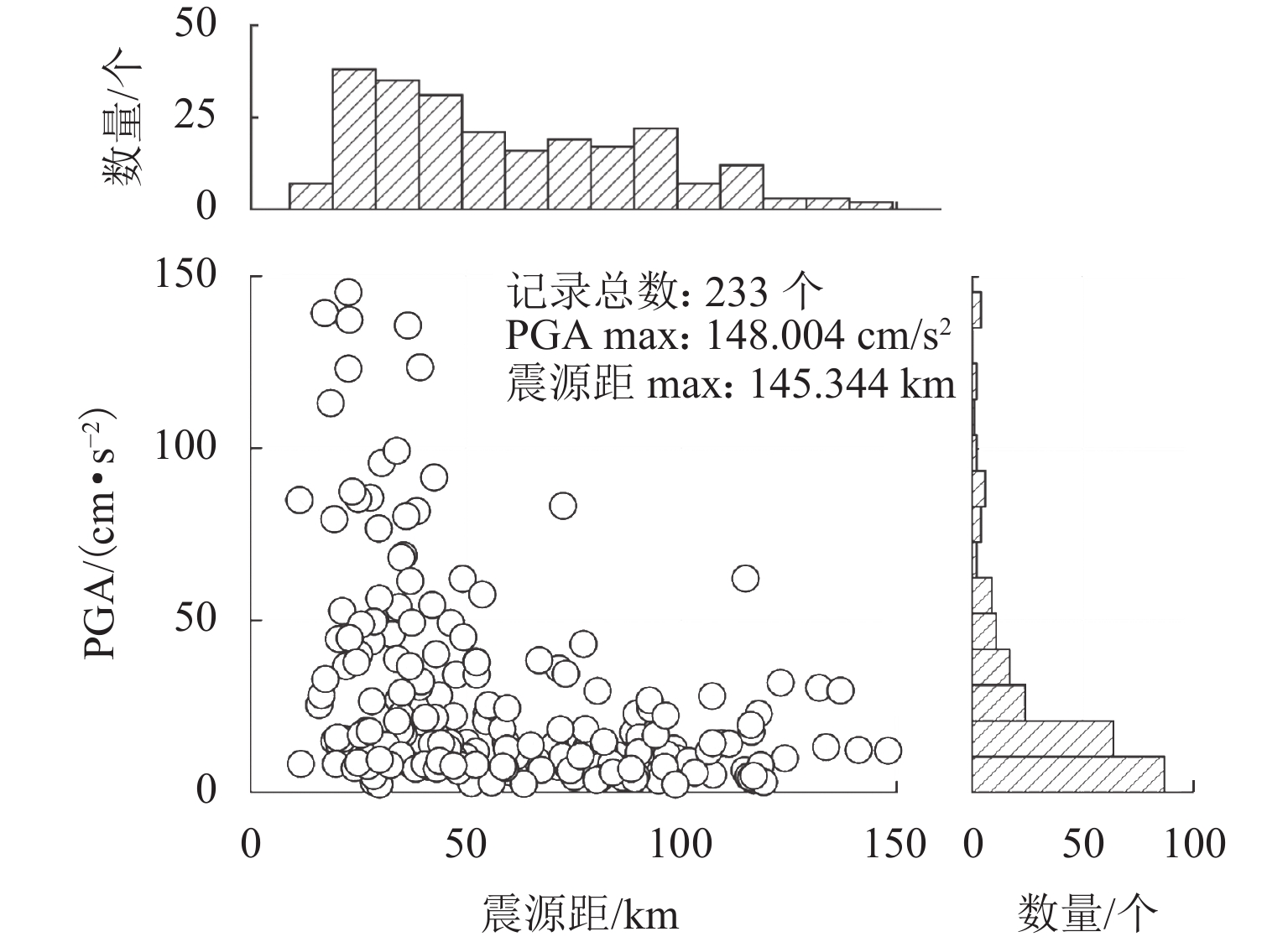
 下载:
下载:
